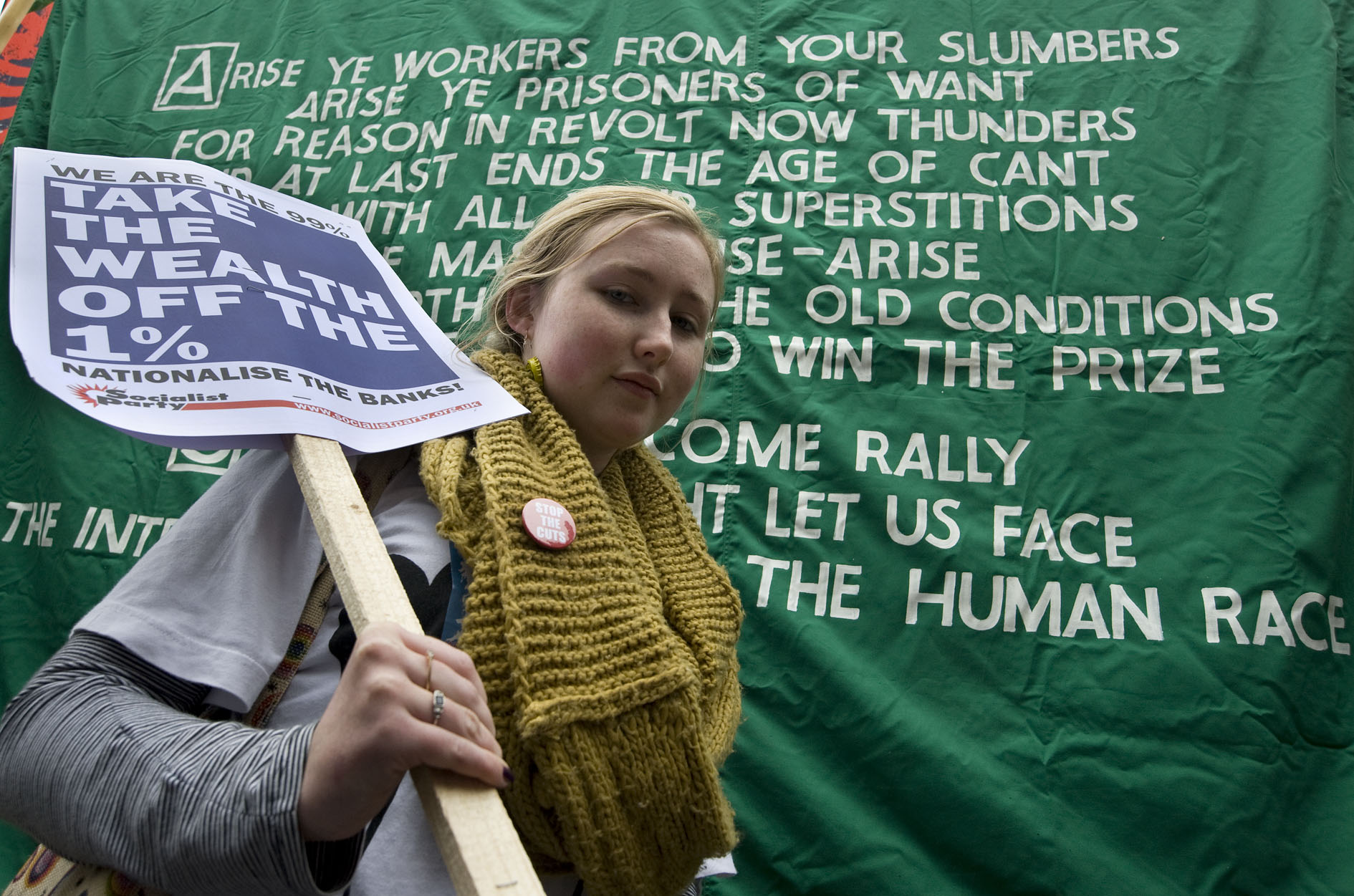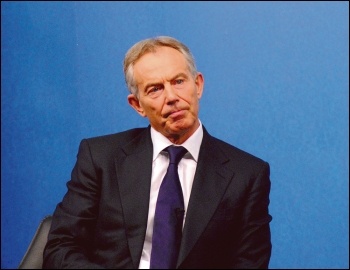Steve Score, Socialist Party national committee
A hundred years ago, in the wake of the Russian revolution, Labour adopted the ‘socialist clause’ in its constitution – Clause IV, part 4. 23 years ago, in 1995, Tony Blair carried through its abolition and replacement with a pro-capitalist one.
The adoption of Clause IV reflected the demands of the organised workers’ movement and the Marxist strand that had always existed in it.
It talked of the aim of the Labour Party as being the “common ownership of the means of production, distribution and exchange” in order to secure for the workers the “full fruits of their labour”.
Its significance in the eyes of many activists was shown by the fact that it was printed on every Labour Party membership card for decades and was understood as the taking of industry and services out of the hands of big business, by means primarily of nationalisation.
It was of course never carried out by the leadership when in power. But there were battles inside Labour between those who really wanted this clause to be implemented and those who saw it as some distant or never achievable aim.
A constitution alone does not define a party of course, what it actually does is key. During the Blair era – and before it – Labour had been transforming into a fully pro-capitalist party.
He saw Clause IV’s replacement as part of the ‘modernisation’ of Labour. In other words, further reassurance to big business that Labour no longer had even the pretence of socialist aims.
How much Labour had changed was reflected by Blair’s success in its abolition, in contrast for example, to right-wing Labour leader Hugh Gaitskell’s failure to eliminate it in 1959.
Jeremy Corbyn
The election and re-election of Jeremy Corbyn as leader of the Labour Party with his anti-austerity stance raises the possibility that Labour could be transformed again.
But as the Socialist has argued, the continued existence of the Blairite wing in local councils, parliament and in the party machine (despite the recent resignation of the Blairite general secretary) means that it is still two parties in one. The potential transformation has not yet been decided.
A reestablishment of a version of Clause IV, even if in more modern language, alongside clear socialist policies would help that process of transformation if it was a serious programme rather than an empty symbol.
The original Clause IV, passed at the Labour Party conference in 1918, was written by Sidney Webb, a member of the Fabians. This group reflected the continuation of a liberal approach within Labour and had no intention of overthrowing capitalism.
It was a compromise by the leadership, knowing they had to concede to the militant and even revolutionary mood that existed among the organised working class at the time.
Labour had been created out of the struggles of workers in the late nineteenth and early twentieth centuries. The eventual realisation of the majority of trade unions that a ‘party of labour’ was needed was crucial.
Marxists played a key role in the process. But from the beginning the leadership was always more pro-capitalist.
The struggle between different wings of the movement was reflected in motions put to conferences. In 1908 the Labour conference passed a resolution calling for: “socialisation of the means of production, distribution and exchange, to be controlled by a democratic state in the interests of the entire community, and the complete emancipation of labour from the domination of capitalism, and landlordism, with the establishment of social and economic equality between the sexes.”
World War One
During World War One, the majority of the leaders of the party and Trade Union Congress supported the government in the imperialist war.
This went along with sacrificing the needs of working class people to the ‘national interest’, accepting the ‘Treasury Agreement’ suspending trade union rights and the Munitions Act that made strikes illegal.
Yet the class struggle did continue during the war. Miners came out on strike against cuts in pay and increasingly the rank-and-file shop stewards movement, originally an unofficial movement, took a lead.
Mass engineering strikes broke out on Clydeside and the Clyde Workers’ Committee was formed. Shop stewards in Sheffield formed their own committee and led strikes against the enlistment into the army of skilled engineers. Similar committees were established elsewhere.
The February revolution in Russia with its reestablishment of the soviets – workers’, soldiers’ and peasants’ councils – and subsequently the October revolution, when they came to power, had a massive impact.
In June 1917 a conference was called in Leeds by the United Socialist Council attended by 1,150 delegates, including some of the Labour leaders.
This conference passed a motion calling for labour movement organisations “to establish in every town…councils of workers and soldiers’ delegates for initiating and coordinating working class activity” and “for the complete political and economic emancipation of international labour”.
The national conference of the Metal Engineering and Shipbuilding committee met in October and came out in support of the Bolshevik revolution.
The call for the establishment of soviets did not materialise, but these events all had an impact on the Labour Party conference which began in Nottingham in January 1918 and reconvened in London in February.
The adoption of Clause IV, part 4 was forced onto the leadership from below. It was a compromise which left out the popular demand of workers’ control in favour of a vaguer “best obtainable system of popular administration and control of each industry or service.”
Conference also agreed a programme including a minimum wage, a 48-hour week, a million houses to be built within two years with capital supplied free of interest by the government, a publicly owned and integrated transport system, a wealth tax and a vast increase in public services.
This was a symbolic turning point in the history of Labour. For the first time it described itself constitutionally as a socialist party.
The dual character of Labour persisted, one where the leadership remained pro-capitalist but it had roots in the working class and a structure that enabled pressure from the base on to the leaders.
Nationalisation
The 1945 Labour government did carry through significant nationalisation and huge steps forward in the lives of working class people such as through the establishment of the NHS, the welfare state and a mass expansion of council housing.
The end of World War Two was again an era of mass pressure, reforms from above relieving the pressure of revolution from below.
The post-war gains were also made possible and were long-lasting because of the long economic upswing. Something that now no longer exists.
However, these nationalisations of key industries such as coal, steel and railways, rather than being part of a democratic socialist plan, were used to prop up capitalism itself and run it in a bureaucratic way.
In the later era of leftward swinging Labour Party membership in the late 1970s and 1980s nationalisation again became a key debate.
Inside the Labour Party, Militant, forerunner of the Socialist Party today, put forward a programme of nationalisation of the banks and commanding heights of the economy under democratic workers’ control and management. A genuine realisation of Clause IV. This would need to be backed up by a mass movement of working class people outside of parliament.
This gained significant support, although those on the reformist left did not agree with it. Yet those around left Labour MP Tony Benn did advocate the nationalisation of the banks and top 25 companies, way further to the left of the programme of Jeremy Corbyn today.
The defeats of workers’ struggles in the late 1980s and the shift in the political situation following the collapse in the Stalinist regimes in Russia and eastern Europe created a new era.
The Labour right were able to take advantage of the dropping socialist consciousness to begin the transformation of Labour, completed under Tony Blair. The expulsion of Militant supporters was the start of that process.
In the new capitalist Labour Party privatisation and the primacy of ‘the market’ was key. Blair’s version of Clause IV, now in Labour’s constitution, replaced common ownership with the “enterprise of the market and the rigour of competition…joined with the forces of partnership”.
But today the reaction against neoliberal austerity, especially following the banking crisis of 2008, has resulted in a new interest in socialist ideas.
Corbyn’s election to Labour leader raises huge hopes of a new approach. Policies of reversing cuts, renationalisation of rail and utilities, raising the minimum wage to £10 an hour, free education and building council homes are all hugely popular.
A Corbyn-led Labour government trying to carry through this programme will face fierce resistance from big business as well as opposition from the Blairites. The Socialist Party fully supports these policies, but would go further.
Socialist plan
To ensure big business is unable to sabotage the economy it is necessary once again to raise the need for the banks and commanding heights of the economy to be brought into public ownership under democratic control.
A democratic socialist plan would then be possible to fundamentally benefit the lives and living standards of the vast majority of society instead of the super-rich.
100 years on, Clause IV is still relevant. Then it reflected the desire of working class people to end capitalism which had created poverty and war.
Today, after record levels of inequality and falls in living standards for the majority, after austerity and the destruction of public services, the debate on a socialist alternative is as important as ever. Building a mass working class party to carry through that programme is vital.
Extracts from Clause IV, part 4, 1918
“To secure for the workers by hand or by brain the full fruits of their industry and the most equitable distribution thereof that may be possible upon the basis of the common ownership of the means of production, distribution and exchange, and the best obtainable system of popular administration and control of each industry or service.”
Extracts from the 1995 version (still in Labour’s constitution)
“We work for: a dynamic economy, serving the public interest, in which the enterprise of the market and the rigour of competition are joined with the forces of partnership and co-operation to produce the wealth the nation needs and the opportunity for all to work and prosper, with a thriving public sector and high quality services, where those undertakings essential to the common good are either owned by the public or accountable to them.”









